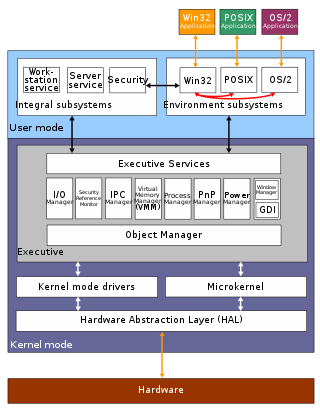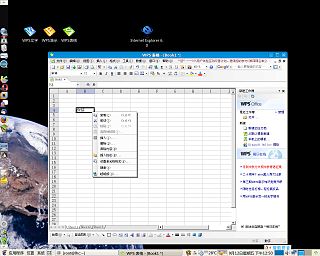A terminate-and-stay-resident program is a computer program running under DOS that uses a system call to return control to DOS as though it has finished, but remains in computer memory so it can be reactivated later. This technique partially overcame DOS's limitation of executing only one program, or task, at a time. TSRs are used only in DOS, not in Windows.

The Windows API, informally WinAPI, is the foundational application programming interface (API) that allows a computer program to access the features of the Microsoft Windows operating system in which the program is running.

x86-64 is a 64-bit version of the x86 instruction set, first announced in 1999. It introduced two new modes of operation, 64-bit mode and compatibility mode, along with a new 4-level paging mode.
NTLDR is the boot loader for all releases of Windows NT operating system from 1993 with the release of Windows NT 3.1 up until Windows XP and Windows Server 2003. From Windows Vista onwards it was replaced by the BOOTMGR bootloader. NTLDR is typically run from the primary storage device, but it can also run from portable storage devices such as a CD-ROM, USB flash drive, or floppy disk. NTLDR can also load a non NT-based operating system given the appropriate boot sector in a file.

In computing, a virtual address space (VAS) or address space is the set of ranges of virtual addresses that an operating system makes available to a process. The range of virtual addresses usually starts at a low address and can extend to the highest address allowed by the computer's instruction set architecture and supported by the operating system's pointer size implementation, which can be 4 bytes for 32-bit or 8 bytes for 64-bit OS versions. This provides several benefits, one of which is security through process isolation assuming each process is given a separate address space.

The Windows Registry is a hierarchical database that stores low-level settings for the Microsoft Windows operating system and for applications that opt to use the registry. The kernel, device drivers, services, Security Accounts Manager, and user interfaces can all use the registry. The registry also allows access to counters for profiling system performance.
Virtual DOS machines (VDM) refer to a technology that allows running 16-bit/32-bit DOS and 16-bit Windows programs when there is already another operating system running and controlling the hardware.

The architecture of Windows NT, a line of operating systems produced and sold by Microsoft, is a layered design that consists of two main components, user mode and kernel mode. It is a preemptive, reentrant multitasking operating system, which has been designed to work with uniprocessor and symmetrical multiprocessor (SMP)-based computers. To process input/output (I/O) requests, it uses packet-driven I/O, which utilizes I/O request packets (IRPs) and asynchronous I/O. Starting with Windows XP, Microsoft began making 64-bit versions of Windows available; before this, there were only 32-bit versions of these operating systems.
The Native API is a lightweight application programming interface (API) used by Windows NT and user mode applications. This API is used in the early stages of Windows NT startup process, when other components and APIs are still unavailable. Therefore, a few Windows components, such as the Client/Server Runtime Subsystem (CSRSS), are implemented using the Native API. The Native API is also used by subroutines such as those in kernel32.dll that implement the Windows API, the API based on which most of the Windows components are created.
The interrupt descriptor table (IDT) is a data structure used by the x86 architecture to implement an interrupt vector table. The IDT is used by the processor to determine the memory addresses of the handlers to be executed on interrupts and exceptions.
The Session Manager Subsystem, or smss.exe, is a component of the Microsoft Windows NT family of operating systems, starting in Windows NT 3.1. It is executed during the startup process of those operating systems.
The Microsoft Windows family of operating systems employ some specific exception handling mechanisms.
The Microsoft Windows operating system supports a form of shared libraries known as "dynamic-link libraries", which are code libraries that can be used by multiple processes while only one copy is loaded into memory. This article provides an overview of the core libraries that are included with every modern Windows installation, on top of which most Windows applications are built.
The Client/Server Runtime Subsystem, or csrss.exe, is a component of the Windows NT family of operating systems that provides the user mode side of the Win32 subsystem. In modern versions of Windows, it is primarily involved with process and thread management, console window handling, side-by-side assembly loading and the shutdown process. Historically, it had also been responsible for window management and graphics rendering, however, these operations have been moved to kernel mode starting with Windows NT 4.0 to improve performance.
The booting process of Microsoft Windows varies between different releases.
Windows NT is a proprietary graphical operating system produced by Microsoft as part of its Windows product line, the first version of which, Windows NT 3.1, was released on July 27, 1993. Originally made for the workstation, office, and server markets, the Windows NT line was made available to consumers with the release of Windows XP in 2001. The underlying technology of Windows NT continues to exist to this day with incremental changes and improvements, with the latest version of Windows based on Windows NT being Windows 11 in 2021.
In computing on Microsoft platforms, WoW64 is a subsystem of the Windows operating system capable of running 32-bit applications on 64-bit Windows. It is included in all 64-bit versions of Windows, except in Windows Server Server Core where it is an optional component, and Windows Nano Server where it is not included. WoW64 aims to take care of many of the differences between 32-bit Windows and 64-bit Windows, particularly involving structural changes to Windows itself.

The Windows 9x series of operating systems refers to the monolithic kernel which powers these operating systems. The basic code is similar in function to MS-DOS. As a 16-/32-bit hybrid, it requires support from MS-DOS to operate.
An Interrupt Request Level (IRQL) is a hardware-independent means with which Windows prioritizes interrupts that come from the system's processors. On processor architectures on which Windows runs, hardware generates signals that are sent to an interrupt controller. The interrupt controller sends an interrupt request to the CPU with a certain priority level, and the CPU sets a mask that causes any other interrupts with a lower priority to be put into a pending state, until the CPU releases control back to the interrupt controller. If a signal comes in at a higher priority, then the current interrupt will be put into a pending state; the CPU sets the interrupt mask to the priority and places any interrupts with a lower priority into a pending state until the CPU finishes handling the new, higher priority interrupt.

Longene is a Linux-based operating system kernel intended to be binary compatible with application software and device drivers made for Microsoft Windows and Linux. As of 1.0-rc2, it consists of a Linux kernel module implementing aspects of the Windows kernel and a modified Wine distribution designed to take advantage of the more native interface. Longene is written in the C programming language and is free and open source software. It is licensed under the terms of the GNU General Public License version 2 (GPLv2).





